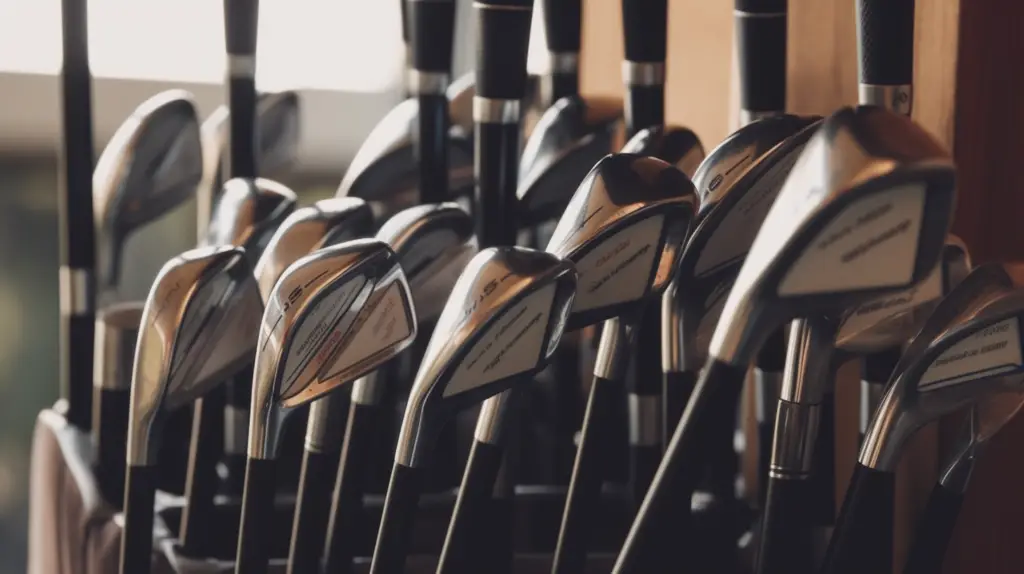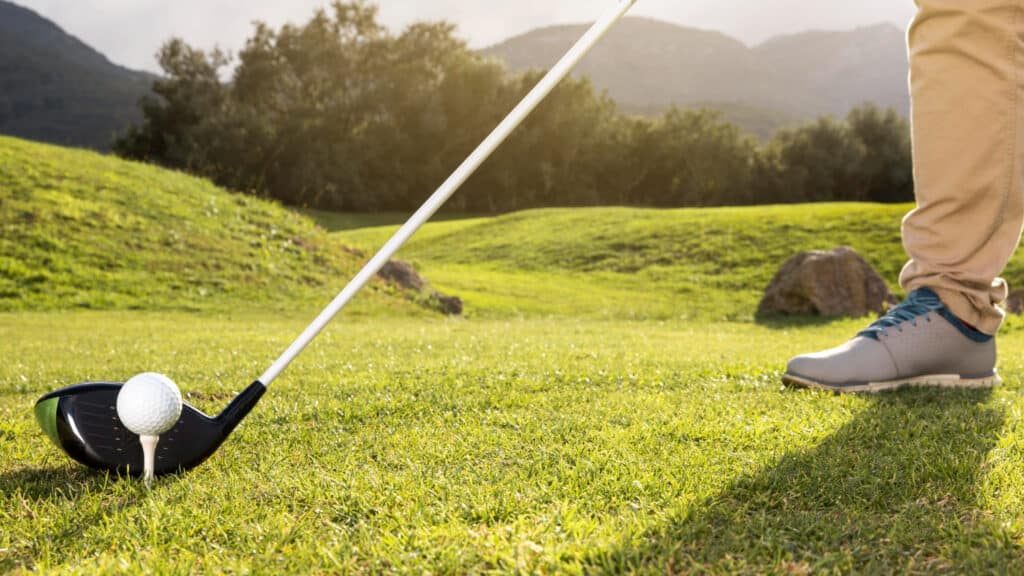Last Updated on November 8, 2023
What is torque in golf shafts? Golf shafts play an important role in the sport of golf, and understanding torque is crucial for selecting a perfect set. Torque is a measure of resistance to twisting when force is applied along the length of the shaft. It is one of many aspects that need to be considered when choosing the right golf club shaft. This article will discuss what torque in golf shafts means and why it matters.
How to Measure Torque in a Golf Shaft
Measuring torque in a golf shaft is an important part of club fitting and can significantly affect the performance of the golfer. Torque measurement provides information about how much flex or bend the golf shaft has when force is applied to it. This allows for adjustments to be made to optimise the player’s swing, distance, accuracy and control.
To measure torque in a golf shaft, a tool called a deflectometer is usually used. The deflectometer measures the amount of bending that occurs during impact with a ball while also tracking the movement of the head relative to its starting point. From this data, torque values are calculated which provide important insights into how well-optimised each club is for the particular player’s game.
Understanding these measurements helps ensure that clubs are properly fitted before they are used on the course. Additionally, professional players may use them as reference points if their games don’t feel optimal even after adjusting other variables such as angle and weight distribution. By measuring torques regularly, golfers have more control over their play and can make necessary changes to maximise performance.
Types of Torque in Golf Shafts
Torque can be divided into three categories: low-torque, mid-torque, and high-torque. Low-torque golf shafts are designed to provide more control over shots and help keep the ball straight even if there is an off-centre hit. Mid-torque shafts offer players increased feel and accuracy while still providing stability when striking the ball. High torque shafts are designed for maximum power but can often cause too much spin on shots which can reduce overall distance.
In addition, golfers should consider tip and butt torques when selecting a golf shaft. Tip torque measures how much force is required at the top end of the club head to create enough flexibility for a player’s desired shot shape or trajectory. Butt torque measures how rigidly a golfer must hold onto their grip to maintain the desired swing path throughout their entire downswing motion. Understanding both types of torque will allow players to find a suitable balance between power, accuracy, and feel that works best for them.
Factors Influencing Torque in Golf Shafts
Torque is an important factor when selecting a golf shaft as it affects the speed and stability of a swing. It can be measured in degrees and determines how much the club head rotates during a swing. The primary factors influencing torque are:
- Golf Shaft Flex – This refers to the stiffness or flexibility of the shaft which affects its ability to bend, causing more rotation during a shot if the flex is higher.
- Shaft Weight – Heavier shafts tend to generate greater torque while lighter ones cause less rotation due to their lower weight and increased whip effect.
- Swing Speed – Faster swings will produce more torque than slower ones since they cause the club head to rotate more quickly at impact with the ball.
- Club Head Speed – As this increases, so does the amount of torque generated by the shaft leading to more spin on shots.
These factors all play an integral role in determining how much torque is produced by a golf shaft during a swing and should be taken into account when making your selection. Ultimately, choosing a suitable golf shaft that matches your playing style and preferences can help you achieve better results on the course
How to Select the Right Torque for Your Swing

Selecting the right torque for your golf swing is an important part of maximising performance. Torque in a golf shaft refers to how much force it takes to bend or twist the shaft during the swing. The ideal amount of torque depends on several factors such as your swing style, tempo and strength.
| Factors | Description | Examples |
|---|---|---|
| Swing Style | How you move through your swing with power and control | Flat plane / upright, one-piece takeaway, full release etc. |
| Tempo and Strength | Speed of your downswing and power generated by muscles used in a shot | Acceleration rate, club head speed etc. |
| Shaft Flexibility | Amount of flex/bend in the shaft when swung at maximum speed | Stiff (low torque), regular (medium torque) and extra stiff (high torque) options available. |
Golfers should be aware that different types of clubs require varying degrees of torque; drivers generally need more torque than irons due to their larger heads which increase momentum when swinging. It’s important to choose the correct measurement technique when selecting the right torque for your desired outcome – launch monitors are particularly useful for this purpose.
Selecting the optimal combination of components tailored specifically towards each player’s unique set-up will result in improved accuracy and consistency from tee to green – making finding the right torque an invaluable step in improving overall performance on course.
Understanding How Torque Affects Performance

Torque is defined as the amount of twisting force a golf shaft produces when swung. It influences how flexible or stiff the club will be and affects performance in various ways, depending on the type of golfer. Higher torque can produce more distance for a slower swinging player, while lower torque may suit a faster-swinging golfer who wants to maintain control over ball trajectory and accuracy.
The flex of a shaft impacts its torque reading – softer shafts tend to increase twist at impact, whereas firmer shafts reduce it. A higher kick point indicates that the midsection of the club is less flexible than the rest and this increases overall stiffness, resulting in increased stability but reduced power potential. Low kick points are usually associated with lighter swingers who need added flexibility and feel, while high kick points help heavier hitters generate maximum speed with greater consistency.
Generally speaking, faster players require low torque shafts to prevent their swings from becoming too ‘loose’ due to excess twist; alternatively, slower swingers benefit from higher torques which offer improved launch angle and spin rate capabilities.
Frequently Asked Questions
What Is the Difference Between Torque and Flex in a Golf Shaft?
Torque and flex are characteristics of a golf shaft that affect the flight path of a shot. Torque is the measure of how much a golf shaft twists when it is swung, while flex refers to the flexibility or stiffness of the shaft. The torque rating describes how quickly a shaft will twist during the swing, with higher ratings indicating more twisting. Conversely, the flex-rating measures how flexible or stiff the shaft will be upon impact with the ball.
Understanding both torque and flex can help players choose an appropriate golf shaft for their game:
Torque:
- High torque rating – More twisting in swing; best suited for slower swings and lower handicap levels.
- Low torque rating – Less twisting in swing; often used by faster swinging players at higher handicap levels.
Flex:
- Stiffer Flex – Use this if you want less club head speed but greater control on your shots.
- Softer Flex – Use this if you want more club head speed but less control on your shots.
It is important to note that different combinations of these two variables could have different impacts on player performance, so it is essential to make sure one has chosen an appropriate combination for their skill level before purchasing a new golf shaft.
How Does One Adjust the Torque of a Golf Shaft?
To begin with, one method to adjust torque is by selecting a golf club that has been designed with adjustable weights or plugs near its head. This allows users to customise their clubs’ weight distribution according to their preferences. Additionally, other ways to alter torque include using different shaft flexes and lengths when replacing old ones. Furthermore, players can purchase aftermarket adapters for their existing clubs, which provide precise control over changes in both length and shaft stiffness.
These options offer varying levels of customisation for players who want to fine-tune the characteristics of their equipment and optimise it for their own abilities and playing style. Not only do they help improve accuracy but also distance by increasing ball speed upon impact. Moreover, proper adjustment of these components will result in improved consistency while swinging as well as greater stability throughout the stroke.
Conclusion
It is essential for players to understand ”what is torque in golf shafts” and how it impacts their ability to hit the ball effectively, and what factors affect it. Overall, understanding how torque works within golf shafts can help players maximise their performance by ensuring they are using equipment best suited to their individual needs and abilities.


